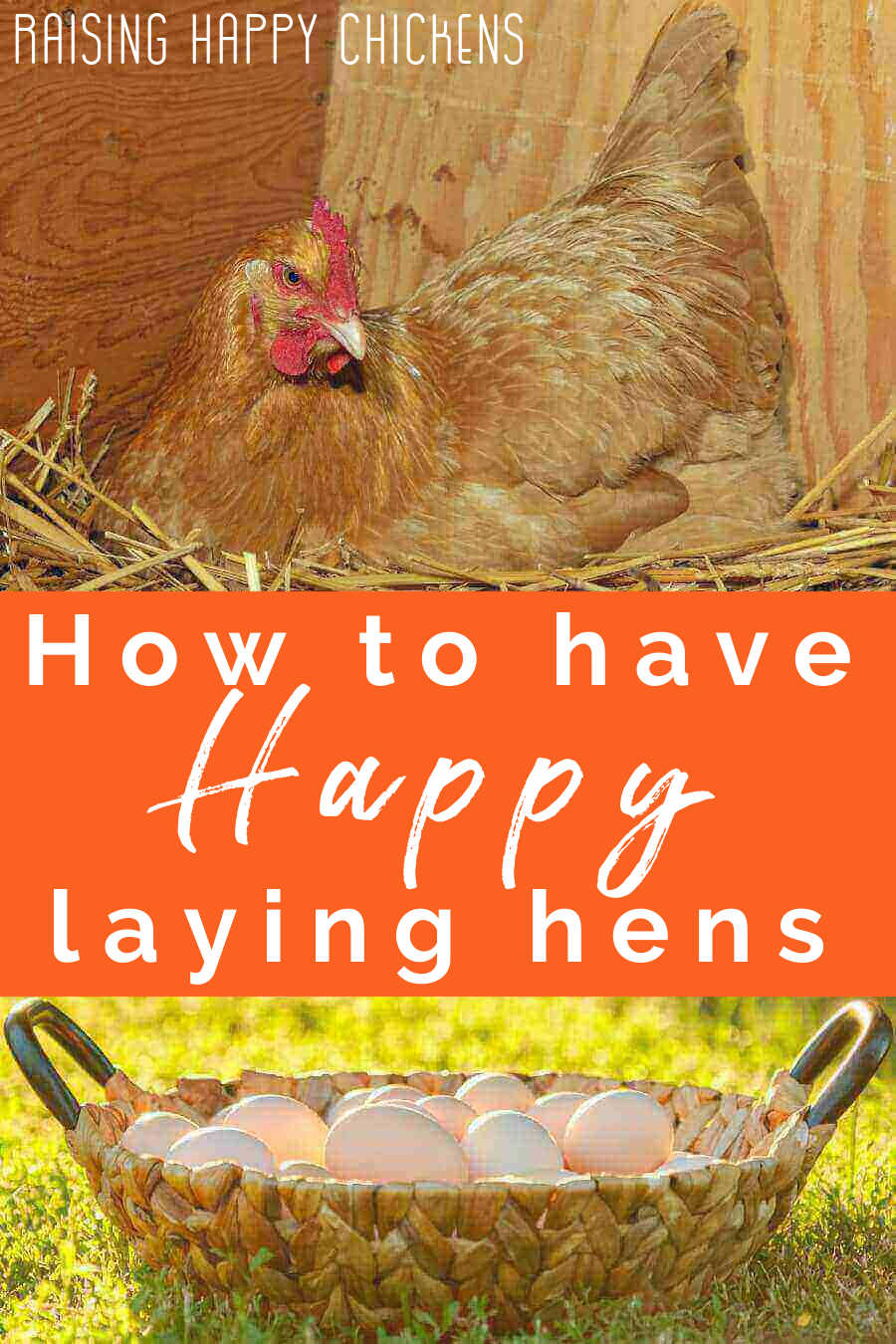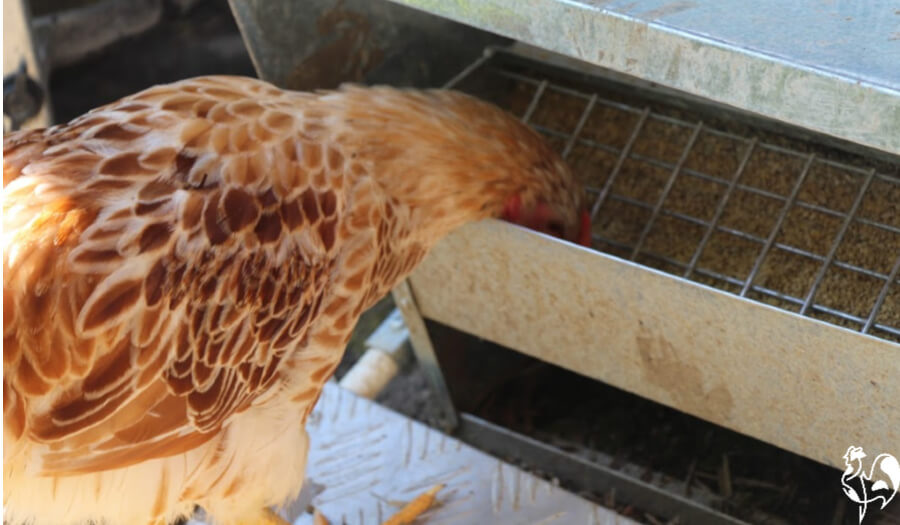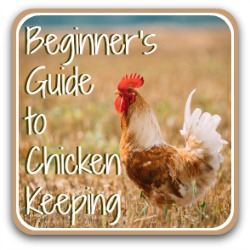Raising chickens for eggs: needs, feeds and breeds.
So you're thinking of keeping hens in your garden or backyard for those amazing freshly laid eggs?
That's wonderful, and I would always say it's worth every minute of your time and every penny of your money.
But is it worth it for you?
In this article, we'll look together at commonly asked questions about laying hens, including:
- a laying hen's needs
- the benefits and costs
- the best breeds
- how properly to care for your layers.
You'll then have all the information to make informed decision about whether raising chickens for eggs is right for you and your family.
Because if you're expecting that cute little chick you hatched yourself to start laying eggs within a few weeks, you need to think again.
Here's what's covered in this article - click any link to go to that section.
Basic requirements: keeping egg-laying chickens safe, stress free and happy.
Nest boxes.
A safe, private place to lay is one of the most basic requirements for hens. For more detailed information about the requirements of nest boxes, see this article.
And for information about how to choose the best possible nest boxes for your flock, the step-by-step details in this article will help.
As a minimum, provide one nest box for every three hens (be prepared though - you'll find they all want to use the same one!). Make sure they're out of the way of any potential predators, and away from the hustle and bustle of life in the coop.
You'll soon discover that they don't always lay where you want them to lay... you'll also discover that they make their displeasure at being interrupted very clear. Take a few seconds to watch what happens when I disturb Miss Gertrude...
Some people choose to hang "curtains" at the front of each one to add more privacy. I don't, but the egg-laying part of my coop is dark and quite separate from the rest, so I don't feel it's necessary.
Make a judgement based on your own coop's set-up.
Minimise stress.
Chickens in general are creatures of habit. Anything out of the ordinary can stress them to the point where they stop laying.
Stress can be anything from sensing predators to overcrowding to heat stress (or being too cold) to illness to something as simple as a different routine!
So as well as nest boxes and good food, providing them with a safe, healthy, stress- and disease- free life is a major factor in making sure your hens lay eggs for as long as possible.
Take a look at this article about good husbandry - it boils down to caring properly for your flock, and it's essential if your hens are going to remain healthy egg-layers.
Remember, too, that a dust bath, which provides a crucial part of chickens' behavioural needs as well as keeping mites at bay, is also critical.
Which food is best when you're raising chickens for eggs?
(Links in this section are "affiliate links", which means that if you click and buy something, I earn a small commission at no extra cost to you).
The best commercial layer feed.
Once a hen begins to lay, she needs a specifically balanced feed to make sure all her nutritional needs are met.
She now needs less protein than she did previously, but more calcium. If she doesn't get the right amount of calcium in food, her need for it to make shells means her body will take it from her bones. Which, of course, will lead to weakened bone structure and the likelihood of fractures.
So from about 18 weeks, before she comes into lay, start your laying chickens on what's commonly known as a "layer feed".
A good quality commercial feed has exactly the right balance of protein, calcium and minerals. The absolute top quality, and what I'd always recommend, is organic, non-GMO food for layers.
Ask about options at your local feed store, which will probably be the least expensive way to buy. Otherwise, a good organic feed is easily sourced online.
Feed it freely, but don't leave it in the coop at night. Chickens don't eat at night, and you run the risk of attracting rats and wild birds into the coop, which can bring disease.
Instead, use an automatic feeder like this one, and allow them free access during the day.
Other food for laying hens.
Hens able to free range can find greens like clover, nutritious weeds, flowers and plants, plenty of insects and perhaps the occasional windfall fruit to eat. Any leafy greens, healthy veg or fruit are a great addition to a hen's diet and can actually alter the nutritional value of her eggs.
Kitchen scraps are fine, but make sure they're not fatty, salty or sugary. Excesses of any of those things are as bad for chickens as they are for humans.
Be careful though. Some foods are potentially fatal for chickens. This article spells out things chickens should not eat - ever.
Treats.
Some treats are healthier than others. Feed your laying hens some of these healthy treats; those who are moulting can be helped with this kind of healthy higher protein food.
But treats, even healthy treats like watermelon, should be offered in moderation.
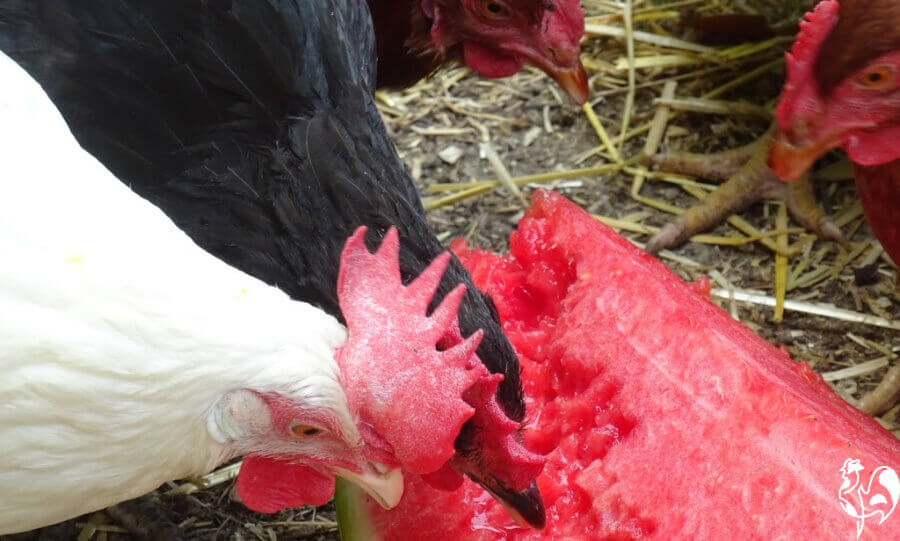 A healthy watermelon treat always goes down well!
A healthy watermelon treat always goes down well!Oyster shell.
No matter what food your hens have, they also need to be offered additional calcium. Around 4 grammes of calcium is needed for every egg. It's needed to keep their egg shells strong, so they assimilate it during the night when the shells form in their oviduct.
Oyster shell is the best way of making sure they have all the calcium they need.
But never mix this into their food.
Feed it freely by putting it in a separate dish. Hens know instinctively when they need calcium, and they'll take it from the bowl.
- Oyster shell is different from grit. All chickens – even baby chicks – need grit to be able to digest their food, but only laying hens need oyster shell.
- If they're outside, they'll find it naturally as they peck in the ground. Find more about the difference in this article.
- Only chickens you're raising for eggs need oyster shell. No need to worry though – roosters know they don't need it, and they'll leave your oyster shell container alone.
- If you can't get oyster shell for any reason, some people use their hens' own eggshells. Make sure they're clean, bake them in the oven for ten minutes and crush them before offering them, again in a separate container.
- I personally don't do this, because my view – and it is only a personal view – is that my hens need additional calcium to what they produce themselves. But it's a personal choice. If it works for you, no problem!
Is the benefit of raising hens for eggs worth the financial cost?
That entirely depends on your perspective. If you're thinking of selling eggs for a profit, you're unlikely to benefit. Store- or even farm-bought eggs are so inexpensive that the cost of raising a hen to the stage where she's laying (called "point of lay") will far outweigh the cost of buying eggs.
On the other hand, the eggs you'll get from your own hens will be literally freshly laid. Shop bought eggs are always several days old before they even reach the point of sale. Their quality, unless they're from truly pastured hens, is (arguably – see below) lower.
The pleasure you'll get from seeing your ladies scratching round in their run, or free-ranging in your garden, is immense. And, if you choose to re-home a hen from a shelter or a battery hen rescue, you're giving them a second chance at a happy, fulfilled life.
Not to mention the benefits of teaching children and grandchildren about caring for other living things.
 As well as being fun, keeping hens is a great way to teach kids where their food comes from.
As well as being fun, keeping hens is a great way to teach kids where their food comes from.So in terms of financial cost, there is no benefit. But in terms of nourishment, entertainment, compassion, and children and grandchildren learning life lessons, the benefits are immense.
How many chickens should you have to provide enough eggs for a family?
Chickens are sociable creatures, so you should always have more than one.
Exactly how many depends on how many eggs you want. A hen bred specifically as an egg-layer, like the Red Star, will lay on average once a day. As days get shorter, though, egg-laying will slow down and, in some cases, stop.
And not all breeds lay every day, so you need to choose your breed carefully.
Do you need a rooster for chickens to lay eggs?
No. Hens lay eggs whether there's a male in the flock or not.
Without a rooster the eggs will not be fertile, so would never have the capacity to grow into chicks. Many people prefer that – and a rooster can be problematic.
Of course, if you want to incubate and hatch your own chicks from your hens' eggs, then you will need a male to fertilise the eggs. In those circumstances they can be a real bonus for the flock.
My Golden Laced Wyandotte rooster, Spartacus, for example, is very good at finding treats to offer his favourite hens, and would defend them to the death.
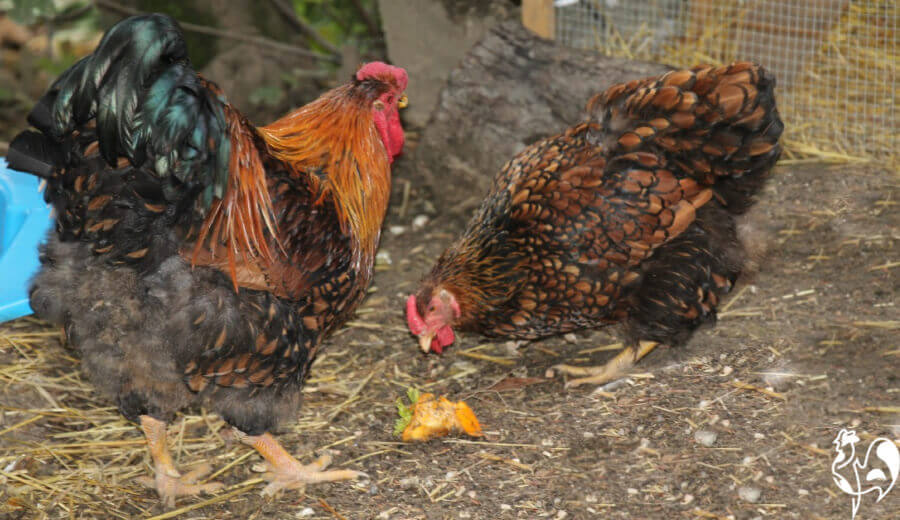 Spartacus finds a tasty treat for one of his favourite hens.
Spartacus finds a tasty treat for one of his favourite hens.Choosing the right egg-laying breed.
If you want a reliable, once a day egg-laying chicken, get a commercial breed. My favourite, not only for laying but for all-round friendliness and entertainment value, is the Red Star – the common, brown chicken.
Red Stars lay a lovely cream-coloured egg which become larger as the hen ages. If you're looking for a reliable white egg layer, take a look at the Livorno, or Leghorn. And my Black Copper Marans hens lay the most wonderful dark chocolate coloured eggs.
Still not sure? Look around your neighbourhood. Talk to other backyard keepers. What breeds are common? Which hens do they consider the best for eggs?
Everyone has their favourite. Be sure to ask specifically about how reliable the breed is as an egg-layer.
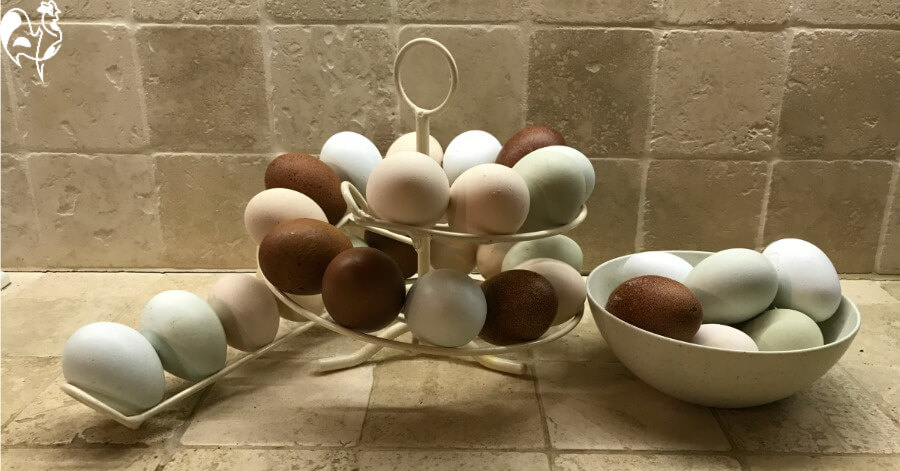 My flock's colourful collection on my egg skelter. (I now have two egg skelters!).
My flock's colourful collection on my egg skelter. (I now have two egg skelters!).When will my hens start to lay?
A female chicken before the age of 12 months is known as a "pullet". She will normally start to lay somewhere in the middle of that time, between 19 and 26 weeks depending on the breed.
In my experience Red Stars are fairly dependable, starting at between 21 and 24 weeks. Other large breeds I've had, like the Wyandotte, have started later, at around 34 weeks.
When you're thinking about which breeds to add to your flock, check the breed club information to discover their egg-laying information.
How to tell when a hen will start laying.
The obvious indicator is her age. But as a hen comes closer to the point of lay, there will be also be some physical signs you should look out for.
- Have you noticed your hen crouching when you approach her or when you place your hand over her back? It's an instinctive behaviour called "squatting", and it's an indication she is about to come into lay.
- She's placing herself ready for the rooster to mate with her – even if you have no rooster. So it means she's matured enough to lay eggs. Expect them within a week or two of this behaviour starting.
- Her comb and wattles will grow and become a darker red rather than the pink-ish colour of younger hens. This is Lulu, one of my first Red Stars. See the difference before and after she came into lay.
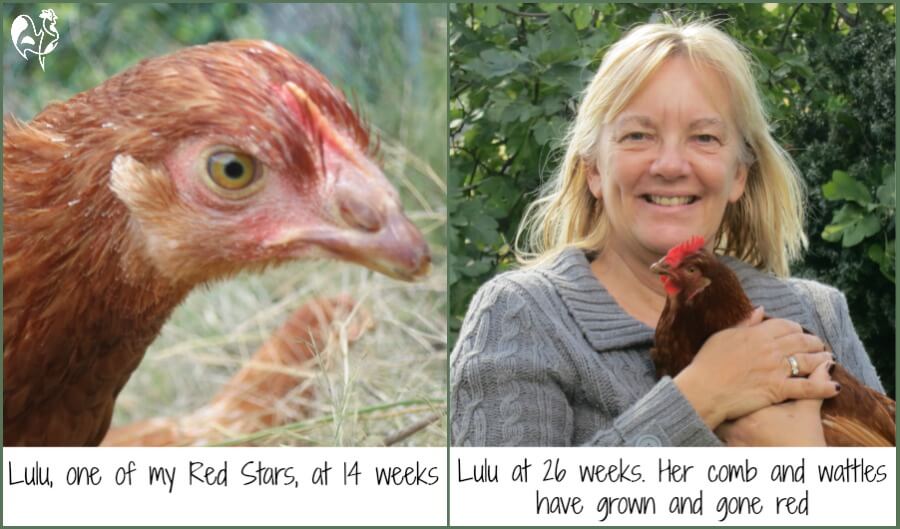
How long will hens lay for?
A healthy hen bred as a layer will lay an egg once a day for at least the first year. Breeds which are not specifically layers vary in how many eggs they'll lay.
Most will slow down as they come into moult in the autumn (fall), when their energy is directed at making sure they have a good covering of feathers to get them through the winter. And all hens will lay fewer eggs as they get older.
Can you make hens lay more than one egg a day?
No. No matter what you read on the internet about feeding them herbs and finding a miraculous increase in egg production, it's physically impossible for a hen to lay more than an egg a day.
It takes between 24 and 26 hours for an egg to form in the hen's oviduct.
The egg-laying cycle is triggered by light, and it is possible to keep hens laying for longer periods of time by adding light to the coop in the winter months.
I choose not to, because I think my hens deserve a break. But if you want to read more about this, see my article about light in the chicken coop.
There's only one solution: if you want more eggs, get more hens!
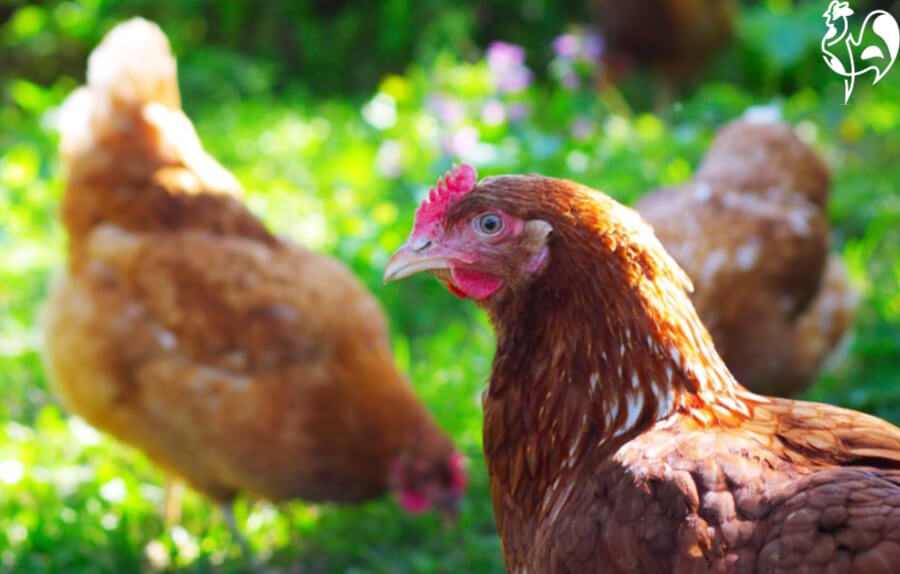
If you found this article useful, here are some others you'll like.
Sources and further reading.
A lot of "facts" you'll find on the internet are often people's individual views, based on inaccurate information repeated from poor quality sources.
The information I provide in this article and others is based not just on my own experience, but on evidenced facts from scientific, peer-reviewed research and books from highly respected and experienced poultry keepers such as Gail Damerow.
Some of the trusted sources I have used in this article are these.
British Hen Welfare Trust: How does my hen produce an egg every day?
Sophie Rehault-Godbert et al: The Golden Egg: Nutritional Value, Bioactivities, and Emerging Benefits for Human Health. Pub. US National Library of Medicine, 2019.
